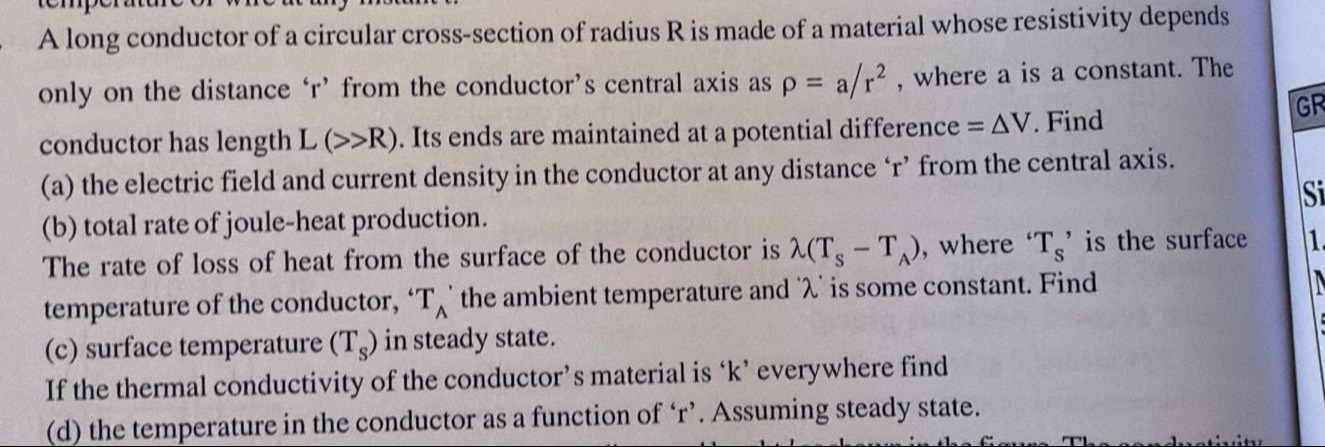Question
Question: A long conductor of a circular cross-section of radius R is made of a material whose resistivity dep...
A long conductor of a circular cross-section of radius R is made of a material whose resistivity depends only on the distance 'r' from the conductor's central axis as ρ=a/r2, where a is a constant. The conductor has length L (>>R). Its ends are maintained at a potential difference = ΔV. Find (a) the electric field and current density in the conductor at any distance 'r' from the central axis.
(b) total rate of joule-heat production.
The rate of loss of heat from the surface of the conductor is λ(Ts−TA), where 'Ts' is the surface temperature of the conductor, 'TA' the ambient temperature and 'λ' is some constant. Find (c) surface temperature (Ts) in steady state.
If the thermal conductivity of the conductor's material is 'k' everywhere find (d) the temperature in the conductor as a function of 'r'. Assuming steady state.

(a) E=LΔV (uniform), J(r)=aLΔVr2 (along the length), (b) Ptotal=2aLπ(ΔV)2R4, (c) Ts=TA+2aLλπ(ΔV)2R4, (d) T(r)=TA+16akL2(ΔV)2(R4−r4)+2aLλπ(ΔV)2R4
Solution
The problem asks for several quantities related to a long conductor with radius R and length L, made of a material with resistivity ρ=a/r2, where r is the distance from the central axis. A potential difference ΔV is applied across the ends.
(a) Electric field and current density: Since the conductor is long (L >> R) and the potential difference is applied across the ends, the electric field E is uniform along the length of the conductor (say, along the z-axis) and its magnitude is given by E=LΔV. The electric field is independent of r. The current density J is related to the electric field by Ohm's law: E=ρJ. Since E is along the z-axis and ρ is a scalar function of r, J will also be along the z-axis. The magnitude of the current density at a distance r from the central axis is J(r)=ρ(r)E. Substituting the expressions for E and ρ(r): J(r)=a/r2ΔV/L=LΔVar2=aLΔVr2. The electric field is E=LΔVz^ (assuming the conductor is along the z-axis). The current density is J(r)=aLΔVr2z^.
(b) Total rate of joule-heat production: The rate of Joule heating per unit volume at a distance r is Pv(r)=J(r)⋅E=J(r)E. Pv(r)=(aLΔVr2)(LΔV)=aL2(ΔV)2r2. To find the total rate of heat production, we integrate the power density over the volume of the conductor. The volume element in cylindrical coordinates is dV=(2πrdr)L. Total power Ptotal=∫0RPv(r)(2πrdrL)=∫0RaL2(ΔV)2r2(2πrdrL). Ptotal=aL22π(ΔV)2L∫0Rr3dr=aL2π(ΔV)2[4r4]0R=aL2π(ΔV)24R4=2aLπ(ΔV)2R4.
Alternatively, we can calculate the total current I=∫0RJ(r)(2πrdr)=∫0RaLΔVr2(2πrdr)=aL2πΔV∫0Rr3dr=aL2πΔV4R4=2aLπΔVR4. The total power is Ptotal=ΔV⋅I=ΔV(2aLπΔVR4)=2aLπ(ΔV)2R4.
(c) Surface temperature (Ts) in steady state: In steady state, the total rate of heat production equals the total rate of heat loss from the surface. The rate of loss of heat from the surface is given as λ(Ts−TA). Assuming this refers to the total rate of heat loss from the cylindrical surface (since L >> R, end effects are negligible). Ptotal=λ(Ts−TA). 2aLπ(ΔV)2R4=λ(Ts−TA). Ts−TA=2aLλπ(ΔV)2R4. Ts=TA+2aLλπ(ΔV)2R4.
(d) Temperature in the conductor as a function of 'r': In steady state, the heat generated within any volume must be conducted outwards. Consider a cylindrical shell of radius r and thickness dr and length L. The heat generated in this shell per unit length is Pv(r)(2πrdr)=aL2(ΔV)2r2(2πrdr)=aL22π(ΔV)2r3dr. The total heat generated per unit length within a cylinder of radius r is Qgen′(r)=∫0raL22π(ΔV)2r′3dr′=aL22π(ΔV)2∫0rr′3dr′=aL22π(ΔV)24r4=2aL2π(ΔV)2r4. In steady state, this heat must be conducted outwards across the cylindrical surface at radius r (per unit length). According to Fourier's law of heat conduction, the radial heat flow rate per unit length across a cylindrical surface of radius r is Qcond′(r)=−k(2πr)drdT. Equating the two rates: Qgen′(r)=Qcond′(r). 2aL2π(ΔV)2r4=−k(2πr)drdT. drdT=−2aL2π(ΔV)2r42πkr1=−4akL2(ΔV)2r3. Now, integrate with respect to r: T(r)=∫−4akL2(ΔV)2r3dr=−4akL2(ΔV)2∫r3dr=−4akL2(ΔV)24r4+C=−16akL2(ΔV)2r4+C. We use the boundary condition that at the surface r=R, the temperature is Ts from part (c). T(R)=Ts=TA+2aLλπ(ΔV)2R4. T(R)=−16akL2(ΔV)2R4+C. So, C=Ts+16akL2(ΔV)2R4=TA+2aLλπ(ΔV)2R4+16akL2(ΔV)2R4. Substituting C back into the expression for T(r): T(r)=−16akL2(ΔV)2r4+TA+2aLλπ(ΔV)2R4+16akL2(ΔV)2R4. T(r)=TA+16akL2(ΔV)2(R4−r4)+2aLλπ(ΔV)2R4.
